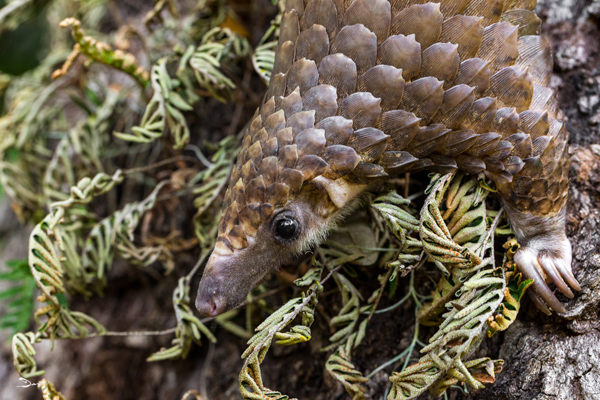- La Feria Community Holds Succesful Business Mixer Event
- Little Nashville to Take Place in Downtown Mercedes
- Lions Basketball Captures District Gold
- La Feria ISD Students Compete in Regional Chess Tournament
- Lions End First Half of 32-4A on a High Note
- La Feria ISD Held Another Successful Parent Conference
- Strong Appearance for Lions at Hidalgo Power Meet
- LFECHS Students Get to Meet Local Actress
- Students Participate in Marine Biology Camp
- Two LFECHS Students Qualify for All-State Band
Gladys Porter Zoo Joins Forces to Save World’s Most Trafficked Mammal
- Updated: May 26, 2017
Brownsville, Texas – The threat of the permanent loss of a rare and unique animal has spurred U.S. zoos, including the Gladys Porter Zoo, into taking action.
Pangolins, also known as “scaly anteaters,” are poorly understood mammals found in Asia and Africa. With cone-shaped heads and hard, overlapping scales, these gentle, armored insect eaters rely upon their ability to roll tightly into a ball when threatened as their primary means of defense. This strategy does little to protect them from poachers, however.
With wild populations of pangolins declining at alarming rates, all eight species of pangolins are facing extinction. Over the past 10 years, more than a million have been illegally taken from the wild, earning them the dubious distinction of being the world’s most trafficked mammal. Their meat is consumed as bushmeat or sold into the exotic food market and their scales are ground up and used in traditional medicine. To-date, efforts to stop their widespread slaughter have failed, and the situation for pangolins has become dire in Asia. African pangolins will soon reach the same critical levels. All eight pangolin species are protected under national and international laws, and two are listed as Critically Endangered on the IUCN Red List of Threatened Species.
Zoos are often the last line of defense for animals whose habitats have largely been destroyed or whose numbers have been greatly reduced due to overhunting. Faced with the sad realization that pangolins are on a trajectory for extinction, a consortium of U.S. zoos, including the Gladys Porter Zoo, developed a plan to secure a small population of white-bellied tree pangolins under professional care. Very little is known about their behavior and physiology and the Pangolin Consortium aims to study them and share its joint research results to assist in field conservation efforts.
The other members of the Consortium are Brookfield Zoo, Turtleback Zoo, Memphis Zoo, Columbus Zoo, Pittsburgh Zoo & PPG Aquarium, and Pangolin Conservation.
Through public outreach, consortium members can reach over 7.8 million people a year with information about pangolins. Despite increased media coverage of the illegal activities surrounding pangolins, most people in North America are unfamiliar with pangolins and the threats to their survival. Consortium members agree that information about pangolins and their plight should be shared on a broad scale, along with details about how the general public can participate in pangolin conservation
Zoological institutions are perfectly situated to study pangolins’ husbandry, reproductive physiology, diseases, and behavior. Along with the establishment of new field techniques, establishing a baseline of information for a species is extremely difficult to accomplish in the wild. In 2018, the Pangolin Consortium plans to hold an international pangolin meeting to bring together field biologists, professional care managers, researchers, veterinarians and other stakeholders to advance the welfare and conservation of all pangolin species.
Caring for these unique animals in a zoo environment is a delicate process, and in the past, pangolins did not thrive well in institutions. However, through diligent research and efforts, including those of the Consortium, pangolins are surviving and doing well under professional care. In fact, during the first year of the program, three of the six Consortium members, including Gladys Porter Zoo, have had successful births.
In addition to propagation and research here in the United States, the Consortium plans to work with zoologists and students from the University of Lomé in Togo, one of the West African countries where pangolins live. The goal is to establish and sustain conservation efforts there. Accordingly, the Consortium has established a conservation grant program that will provide funding to support in-country conservation and research
The Gladys Porter Zoo houses seven white-bellied pangolins in its Pangolin Research Station behind-the-scenes at the Zoo. “The staff here are genuinely excited about learning all it can about this poorly-known, curious little animal. They are proud of their successes to-date and will continue their work investigating behaviors, health issues and reproductive patterns. It is exciting to be involved in such a major conservation effort,” says Dr. Patrick Burchfield, Director at the Gladys Porter Zoo. “In 1974, we received a single Asian pangolin, Pansy, and kept her for several years,” he continued. “Eventually, we sent her to the Lincoln Park Zoo in Chicago to be paired with a male. It is good to be able to work with pangolins again.”
Off exhibit at Gladys Porter Zoo, the animals are relaxed and comfortable around the keepers. They are fed a carefully balanced diet with a base made up of different pulverized insect larvae. Zoo keepers and veterinary staff continue to monitor their health and behaviors and make adjustments as needed.
White-bellied tree pangolins have a distinctive look, with a long prehensile (grasping) tail, and a body that is covered with sharp, overlapping, artichoke-shaped scales made of keratin, which is the same material that makes up fingernails and hair. A full grown tree pangolin is about the size of a small house cat. Pangolins have a long muscular tongue covered with sticky saliva – perfectly designed to scoop up ants and termites.
Adult pangolins can eat up to 20,000 ants and termites a day, which translates into 7.3 million insects per year.
Pangolins have been observed to be solitary animals, with males and females generally coming together only for mating. Females give birth to a single baby. A baby’s scales are soft but begin to harden within days of its birth. Young pangolins do not walk for several weeks, but cling to their mother’s tail. At approximately four to six months of age, they are weaned and ready to be on their own.



